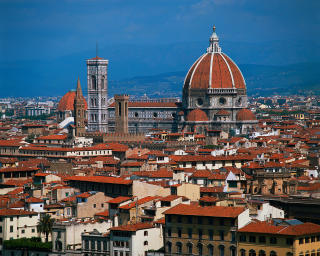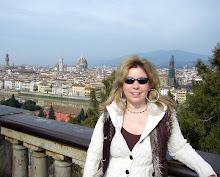
1. Even beautiful Florence, with her centuries of rich artistic, literary, and scientific history, is not immune from that blight we often see in American cities. Yes, I’m talking about the colossal, ostentatious, tacky tour bus. Here’s one up at Piazzale Michelangelo, effectively blocking out the entire Florence skyline, with the Duomo just managing to peak over it.
2. Churches in Italy are sacred places; therefore, you’re not allowed to take pictures in them. Doing so is disrespectful and sacrilegious. Regardless, you’ll still see some tourists now and then who think the rules don’t apply to them. A few weeks ago when I was in the Church of San Miniato al Monte, the interior was completely dark except for the light coming in through small windows, which made it all the more haunting and mystical. That is, until a woman came in, flashing away with her camera, completely ignoring the rules and customs. I was grateful when she left, presumably heading back to her big tacky tour bus.
3. At first I thought is was because I was so spoiled by the good bread that we’re served in restaurants in San Francisco. After all, sourdough bread is so rich in texture and flavor. Somehow the bread I’m served in restaurants in Florence tastes oddly bland. And then I found out why. Tuscan bread is prepared without salt, which means that, basically, it’s flavorless. In addition, one of our students was scolded by a waiter at the Golden View Open Bar restaurant for dipping her bread in olive oil, something that is apparently frowned upon in Italy. And butter is never served with the bread. So what is the point of it? I’m still trying to find out the answer to that one! And the irony, of course, is that you actually pay for this bread as it’s part of the servizio (service charge) that is added to your bill.
4. I’ve discovered the Murphy’s Law of apartment living in Florence. The moment you do laundry and then hang it out neatly to dry on your clothesline, without fail it will start to rain. It’s kind of like that washing-the-car thing back in the States!
5. Speaking of rain, I’ve mentioned before how clean the streets of Florence are, with the street sweepers coming by regularly, several times a day. Interestingly, they come by to do their job, even when it’s pouring down rain.
6. One thing those street sweepers don’t have to clean up are to-go coffee cups. That’s because I have yet to see a place where you can get coffee to go. Italians drink their coffee on the spot, right after it’s been freshly prepared and is still hot. And they drink their coffee out of beautiful white porcelain cups. No, you won’t see any grande and venti cardboard Starbucks cups with plastic lids around here!

7. I’ve got mail! Yes, I received my first mail this past Saturday! I knew that Chip had sent me something before Valentine’s Day, and I had yet to receive it. Every day I eagerly checked my mail box, but it was always empty. I had pretty much resigned myself to the fact that the package had probably gotten lost somewhere in the bureaucratic nightmare that is the Italian postal system, likely never to be seen again. But then, as I was leaving the apartment on Saturday, there it was, sitting at the bottom of the stairs: a package from the U.S.! I was so excited, especially when I saw that it was from Chip. Inside were a Valentine’s card, which is now sitting on my mantle, and a CD from the musical Jersey Boys, which I had seen, and absolutely loved, right before leaving for Florence. You know, I had forgotten how exciting and special it can be to receive good old-fashioned mail.










 Today many students left Florence for the first time since arriving three weeks ago. Their destination? San Gimignano and Siena. A large group met at the Santa Maria Novella Station at 8:30 to get on one of four buses bound for the Tuscan countryside. Two buses when to Siena first, followed by San Gimignano, with the other two buses taking the opposite route. I was on the bus that took us to San Gimignano first.
Today many students left Florence for the first time since arriving three weeks ago. Their destination? San Gimignano and Siena. A large group met at the Santa Maria Novella Station at 8:30 to get on one of four buses bound for the Tuscan countryside. Two buses when to Siena first, followed by San Gimignano, with the other two buses taking the opposite route. I was on the bus that took us to San Gimignano first.











































